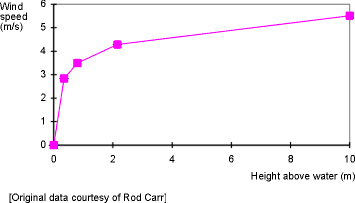For the casting geeks, here is a 500 frame per second analysis of a series of fly casts performed by two expert casters. The maximum fly line velocity obtained was an average of 24 m/s or about 54 mph (see figure 2 and Table 1). That is the maximum line speed these experts could achieve.
A 10 mph headwind would increase drag by almost 30%, a 20 mph head wind would increase drag by 43%, and a 40 mph headwind by 67%
That is why casting into a headwind by is so difficult. With lesser line speed, and larger loop size, the aerodynamic drag increase is even greater.
http://www.flycastinginstitute.com/e-libraryfiles/FCI_E-L_Rod_Cast_102507.pdf
I showed that the maximum line velocity at the fly rod tip at the stop was 54 mph in the example (Figure 2 and Table 10 above.
IMMEDIATELY after the stop the fly line begins to slow down due to aerodynamic drag. In still air, the only drag is due to the forward line velocity. Since drag is proportional v^2, as forward line velocity decreases, there is an ever greater proportional drop in aerodynamic drag from the value at max velocity.
However, in a headwind, the line speed may drop BUT the wind velocity does not, so aerodynamic drag remains much higher. Eventually, if the wind velocity is high enough, the drag is greater than the remaining forward energy of the line and the line will actually be pushed back.
Meanwhile gravity is pulling the line down. The higher the cast is directed above the horizon, the longer it takes for the line to drop. Should the the line still be in the air when the wind velocity overcomes the forward line energy, the fly line will be pushed back toward the caster UNTIL gravity drops the line to the water or ground.
That is the reason we want to direct the cast at a downward angle - this leaves minimal vertical distance as the cast extends for the line to be blown back. There is a difference between directing the line downward from a vertical cast and doing a Reverse Belgian cast in which the entire forward cast is low and parallel to the water.
In the overhand cast directed downward, the rod stop is higher say at about 10 o'clock. As the loop unfurls after the stop, the lower limb of the loop is stationary and is fixed by the rod tip. This section of line has NO FORWARD VELOCITY and therefore, NO FORWARD ENERGY. This stationary downward angled section of line acts as a SAIL. It is a thin sail, but a sail none the less. It is a thin sail that is at an angle to the wind, and so it presents a proportion of its surface into the wind.
What happens is that the wind creates a backward drag on that line. The line does not actually move backward because the forward loop of the line is still moving and unrolling forward. BUT what this backward drag does is to consume some of the forward kinetic energy and slows down the forward velocity of the loop. Eventually the forward energy is consumed and the loop straightens OR the line does not extend and it is blown back.
Now when we make a low sidearm forward cast, the line from the rod tip to the unrolling loop is straight into the path of the wind. So the drag along the line surface is minimized; it is NOT angled into the wind. Furthermore, the entire line is going through a section of wind velocity that is lower so there is less overall drag. Finally, when the forward energy does die out, the entire line is at a lower level and there will be less blow back before the line hits the water.
Here is a graph of the wind gradient above water. It is from a study done for sailing ships, a higher sail grabs more wind.
I stated above that drag is proportional to velocity squared (v^2) so each little bit of decrease in wind velocity closer to the water surface means a longer cast.
Note also that the MAXIMUM line speed generated by ELITE casters is 54 mph. So any additional facing wind effect increases drag tremendously since the resultant drag is based the Square of the base forward line velocity.
That is why a 10 mph headwind, whihc would increase effective line speed from 54 mph to 64 mph (an 18% increase) would increase drag by almost 30%, a 20 mph head wind would increase drag by 43%, and a 40 mph headwind by 67%


